So you want to get a goldfish, huh? Right on! Goldfish make great starter pets. But before you run out and grab one of those glass fish bowls, let’s chat about what size tank your new little buddy really needs.
So How Big Of A Tank Does A Goldfish Really Need? Goldfish need a tank that can hold a minimum of 20 gallons of water to thrive. This can change due to many reasons and let me explain this to you.
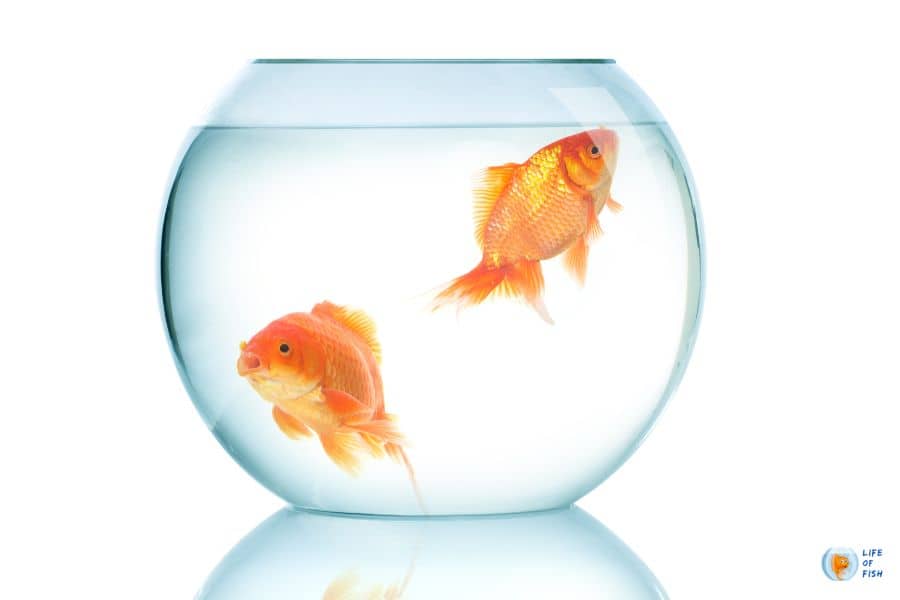
Goldfish Get Pretty Dang Big
Jump To
- 1 Goldfish Get Pretty Dang Big
- 2 The Bare Minimum Tank Size
- 3 More Room Means Happier Fish
- 4 Tank Shape Matters Too
- 5 Keep That Water Fresh
- 6 Give Your Goldie The Space They Deserve
- 7 Goldfish Tank Size Requirements
- 8 Limitations of a Small Tank
- 9 Goldfish Tank Setup
- 10 Goldfish Diet
- 11 FAQs about Goldfish Tank Size
- 12 Give Your Goldfish Lots of Room
Believe it or not, goldfish can grow up to 12 inches long! That’s basically the size of a football. And fancy goldfish with super long fins like Orandas and Ryukins need even more room to swim around. We’re talking a minimum 50 gallon tank for one of those big boys.
See, when goldfish are young they stay pretty small. But they grow quick! And if you cram them into a tiny bowl, it can stunt their growth and cause health issues. Not cool.
So while they may start out cute and tiny, you need to be prepared with a tank that’ll house a full-grown goldie.
The Bare Minimum Tank Size
Generally, you’ll want at least 10 gallons of water for your first goldfish. And another 10 gallons for each additional fish.
So for example:
- 1 goldfish = minimum 10 gallon tank
- 2 goldfish = minimum 20 gallon tank
- 3 goldfish = minimum 30 gallon tank
And if you have fancy varieties, go bigger! Like a 20 gallon tank for one fancy goldfish.
More Room Means Happier Fish
Now just because 10 gallons is the bare minimum, more space is always better. Goldfish love to zoom around and explore. So the bigger the tank, the happier your fish will be.
We’re talking more room to swim, more spots to hide, and more space between tank mates. A cramped tank means bored, stressed out fish. And trust me, that’s no fun for anyone.
So if you can, go bigger than the minimum recommendation. Your goldfish will thank you!
Tank Shape Matters Too
Goldfish don’t just need space, they need the right shaped space. Fancy goldfish with long flowing fins aren’t the strongest swimmers. They need wide tanks that are shallow front to back.
While common single tail goldfish are speedy! They need taller tanks with more depth to really stretch their fins.
When choosing a tank, think about what kind of goldfish you have and pick a shape that matches their swimming style.
Keep That Water Fresh
Now goldfish are known for being uh…a bit messy. They produce a lot of waste and can dirty up a tank pretty quick.
Small tanks mean toxins build up fast. So you’ll be scooping poop constantly with lots of water changes. Bigger tanks dilute the waste better so you can slack a bit on cleaning day.
But no matter the size, you gotta stay on top of water quality. Test for ammonia and nitrates. Gravel vac every week. And change out 25% of the water at least twice a month.
This keeps the water fresh and your fish healthy!
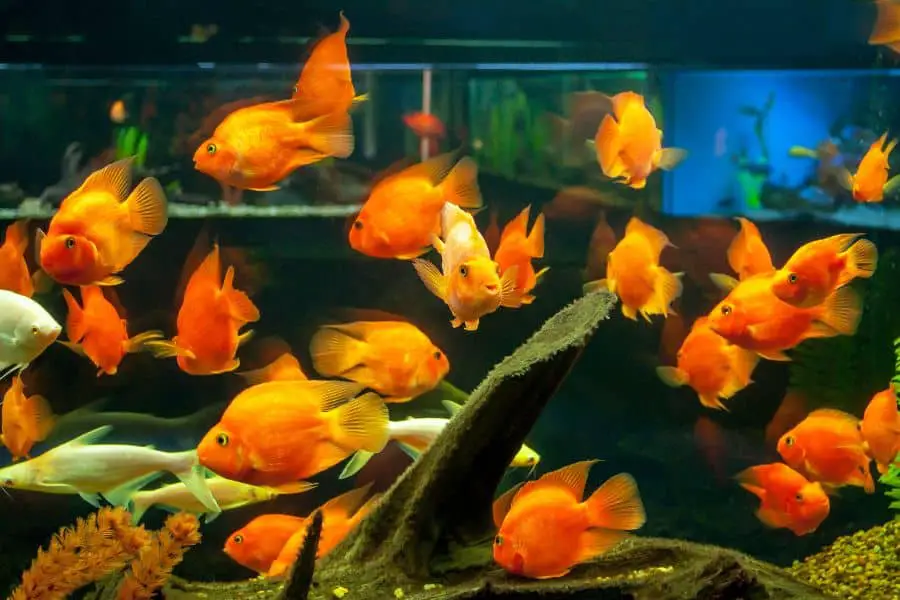
Give Your Goldie The Space They Deserve
Goldfish are living creatures that require lots of care and a properly sized home. When you commit to one, you commit to giving it an environment where it can thrive!
While a bowl may look cute, it cramps your fish’s style. Do what’s right and get the biggest tank you can fit. Watching them explore their space and grow to full size will be super rewarding!
Goldfish Tank Size Requirements
Now that we’ve covered the basics, let’s dive deeper into goldfish tank size based on specific types of goldfish.
Fancy Goldfish
This includes popular varieties like:
- Orandas
- Ryukins
- Fantails
- Moors
- Bubble Eyes
Fancy goldfish have those signature long, flowing fins. And they can reach lengths of 8-12 inches when fully grown.
For fancy goldfish, the general rule is:
- 20 gallons for the first fish
- 10 extra gallons for each additional fish
So for example:
- 1 fancy goldfish: 20 gallon minimum
- 2 fancy goldfish: 30 gallon minimum
- 3 fancy goldfish: 40 gallon minimum
And given their limited swimming ability, opt for a wide tank over a tall one. Fancies need that extra surface area to cruise around.
Common Goldfish
Unlike their fancy cousins, common goldfish have a single tail fin. This allows them to swim faster and with more agility.
Common goldfish actually grow larger than fancies. Expect them to reach 10-16 inches long.
For common goldfish, aim for:
- 30 gallons for the first fish
- 20 extra gallons per additional fish
So for example:
- 1 common goldfish: 30 gallon minimum
- 2 common goldfish: 50 gallon minimum
- 3 common goldfish: 70 gallon minimum
And since they are strong swimmers, common goldfish need taller tanks with more depth.
Comet Goldfish
Comets are a popular breed of common goldfish. They are known for those bright orange and red colors.
Due to their active nature, comet goldfish need a ton of swimming space. They can grow over 12 inches long!
For comets, provide:
- 75 gallons for the first fish
- 50 extra gallons per additional fish
Meaning:
- 1 comet goldfish: 75 gallon minimum
- 2 comet goldfish: 125 gallon minimum
- 3 comet goldfish: 175 gallon minimum
Yeah, we’re talking some monster tanks here. But that’s the only way to keep these speedy fish happy!
Shubunkin Goldfish
Shubunkins are a single tail variety known for their calico color patterns. They stay on the smaller side, reaching about 8 inches full grown.
For these guys, shoot for:
- 20 gallons for the first fish
- 10 gallons for each extra fish
So for instance:
- 1 shubunkin: 20 gallon minimum
- 2 shubunkin: 30 gallon minimum
- 3 shubunkin: 40 gallon minimum
Pond Goldfish
Fancy goldfish kept outdoors in ponds can grow even larger than their indoor counterparts. Expect lengths of 12-16 inches.
For pond goldfish, provide:
- 20 gallons of water per fish
Meaning a 100 gallon pond could comfortably hold 5 average sized fancy goldfish.
And for common goldfish kept outside, allow:
- 30 gallons of water per fish
So that same 100 gallon pond would be best for just 3-4 common goldfish.
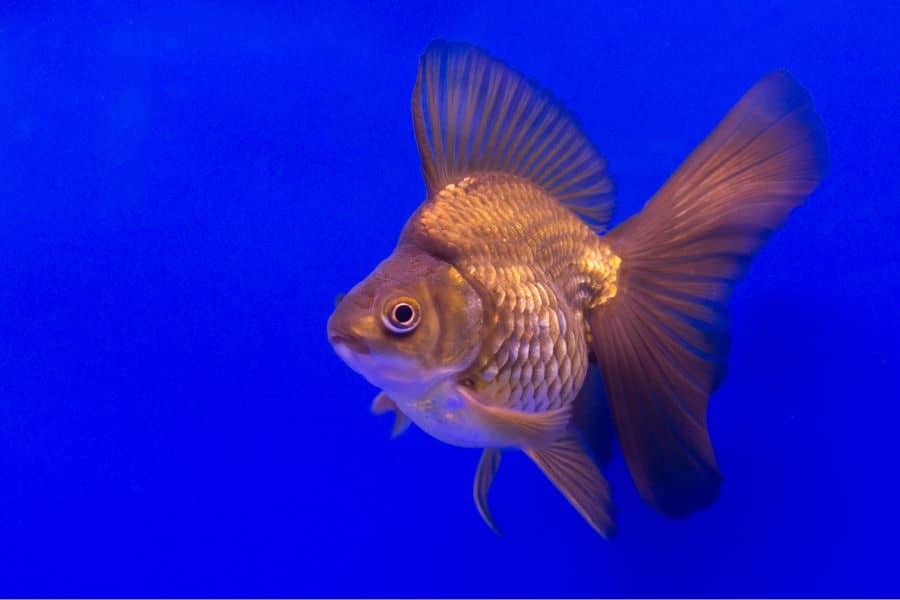
Limitations of a Small Tank
Clearly goldfish need some major tank space. But what actually happens when you keep them in a small tank? Here are the downsides:
Stunted Growth
Goldfish never stop growing. In tiny tanks, they can’t reach full size. Stunting leads to organ issues, swim bladder problems, and early death.
Ammonia Build Up
Goldfish produce lots of waste. In a small tank, ammonia spikes fast. This burns gills and poisons fish. Frequent water changes are a must.
Oxygen Depletion
Surface area matters for gas exchange. A bowl has little surface area relative to the water volume. Low oxygen causes huge problems.
Fin Issues
Long finned varieties need open swimming lanes. In cramped tanks, gorgeous fins get torn and damaged on objects and decor.
Boredom & Stress
Goldfish are active and social. Limited space leads to boredom and aggression between fish. Stressed fish become susceptible to disease.
Difficult Maintenance
Small tanks require more frequent cleanings, water testing, and equipment upgrades to stay livable. Too much work for most owners.
Short Lifespan
In optimal tank conditions, goldfish live 10-20 years. They average only 5 years in tiny tanks. Give your fish the long life they deserve!
Caring for Goldfish in Small Tanks
While less than ideal, sometimes you have to make due with the smaller tank you already own. Here are some tips to keep your goldfish healthy until you can upgrade their home:
- Do very frequent water changes, up to 50% daily, to control ammonia. Use a liquid test kit to track levels.
- Use a high powered filter rated for a much larger tank. This will help process waste more efficiently.
- Consider adding a bubbler or air stone. The extra surface agitation improves oxygen exchange.
- Feed very sparingly, just once or twice a day. Uneaten food fouls the water fast.
- Scoop out solid waste daily with a net to keep the bottom clean.
- Add live plants like java fern and anubias. They absorb fish waste and release oxygen.
- Keep lighting dim if algae is a problem. Consider a 3-4 day blackout to kill it off.
- Test pH regularly and correct any swings. Fluctuating pH stresses fish.
- Do not overstock with tank mates. This exponentially increases waste.
- Check parameters like nitrite and hardness to ensure basic water quality.
- Fast fish 1 day a week. This gives their digestive system a break.
With diligence, you can mitigate some downsides of a small tank. But again, upgrading to a larger tank is highly recommended and should be a top priority for a better quality of life for your goldfish.
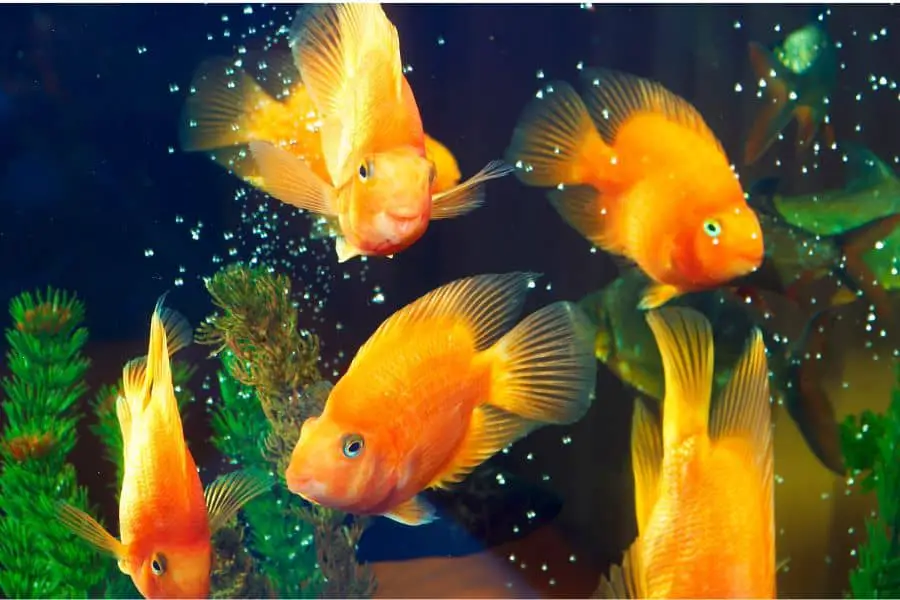
Goldfish Tank Setup
Once you decide on an appropriately sized tank, setting it up properly for goldfish is key. Here are some guidelines for a healthy goldfish tank:
Filtration
Goldfish are such messy fish! A robust filtration system is crucial to handle the bio load.
For goldfish, your filter should have a flow rate at least 10 times that of your tank’s volume.
So if you have a 50 gallon tank, you need a filter rated for 500+ gallons per hour. Two filters are better than one for redundancy.
Canister filters or sumps work well since they have room for extra mechanical and biological media.
Substrate
Bare bottom tanks are easiest to clean, which is helpful for goldfish. But sand or fine gravel can work too.
Avoid large gravel, as goldfish may try to eat it and risk choking or gut impaction. The gravel should also be smooth to prevent fin damage.
If using gravel, allow 1-2 pounds per gallon of tank size. Wash well before adding. Vacuum at water changes.
Decorations
Goldfish appreciate places to explore, rest, and hide. But avoid decor with rough edges that can tear flowing fins.
Some good goldfish safe options include:
- Smooth river rocks
- Driftwood
- Silk plants instead of plastic
- Ceramic pots or vases
- Rounded cave structures
Avoid pointy plastic plants, sharp substrates like crushed coral, and abrasive decorations.
Tank Mates
Single tail goldfish do best with others of their own kind. But avoid pairing long-finned varieties together, as they will nip each other’s fins.
Other possible tank mates include:
- Bristlenose plecos
- Clown loaches
- Weather loaches
- Fast schooling fish like danios
Do not keep goldfish with aggressive species that can attack or fin nip like cichlids, tiger barbs or sharks. Avoid slow moving fish as well, as they will be outcompeted at feeding time.
Plants & Lighting
Low light plants like Java fern, anubias and mosses do well with goldfish. They can withstand nibbling and help purify the water.
Use plant weights and superglue gel to attach plants if goldfish keep uprooting them.
Avoid artificial lighting over 8-10 hours daily, as this can cause excess algae. Put lights on a timer if needed.
Water Parameters
Maintain water conditions in the following ranges for healthy goldfish:
- Temperature: 65-75°F
- pH: 7.0-8.0
- Ammonia & Nitrites: 0 ppm
- Nitrates: <40 ppm
- Hardness: 100-350 ppm
Perform regular partial water changes to keep nitrates down and replenish trace minerals. Use conditioner to remove chlorine and chloramines whenever replacing water.
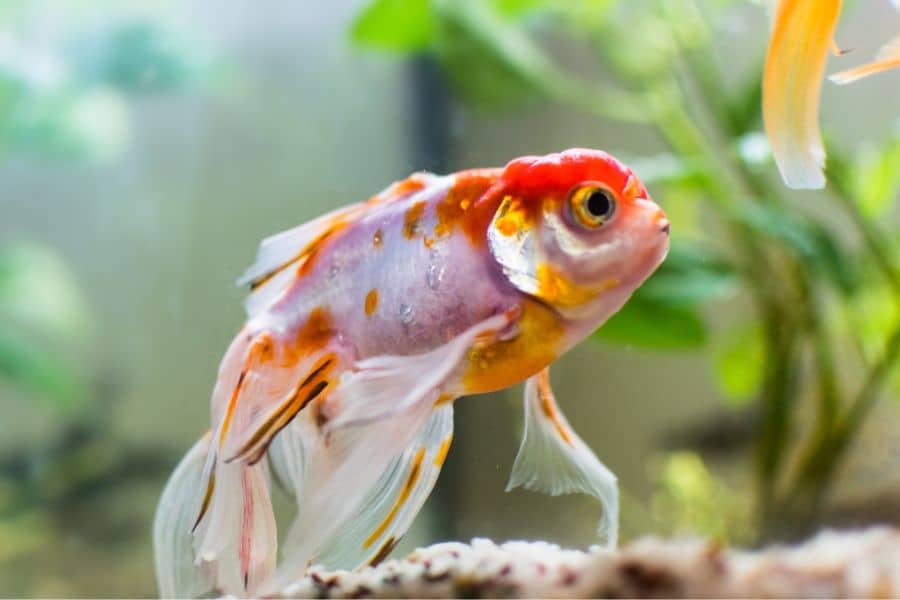
Goldfish Diet
Goldfish will eat constantly given the chance. Feed them a varied diet to keep them healthy. Here are some great goldfish food options:
- Sinking pellets high in plant matter, but with added protein
- Freeze dried worms, brine shrimp or daphnia for treats
- Blanched vegetables like zucchini, peas or spinach
- Live foods like brine shrimp or blackworms
- Thawed frozen foods like bloodworms or mysis shrimp
Avoid overfeeding, as uneaten food quickly pollutes the tank. Start with small portions of food 2-3 times daily. Adjust amounts based on how much they consume in 2-3 minutes per feeding.
Supplement daily meals with treats or veggies 2-3 times per week for variety. Offer live or frozen foods sparingly as they are more fattening.
FAQs about Goldfish Tank Size
To sum it all up, here are answers to some frequently asked questions about goldfish tank sizes and care:
How much space does a goldfish need?
Fancy goldfish need at least 20 gallons for the first fish and 10 more gallons per extra fish. Single tail goldfish need at least 30 gallons for one fish and 20 more gallons per additional fish added.
What is the best tank size for 3 fancy goldfish?
A 40 gallon breeder tank is the recommended minimum size for a group of 3 fancy goldfish. This allows plenty of horizontal swimming space.
Can a goldfish survive in a 5 gallon tank?
While it may survive for a short time, 5 gallons does not allow room for a goldfish to thrive. It will stunt growth and lead to health problems. Aim for at least 10 gallons for one fancy goldfish.
Do goldfish only grow to the size of their tank?
This is a myth. Goldfish grow based on genetics and food, not tank size. They become stunted in small tanks but do not stop growing proportional to the tank dimensions.
Are goldfish solitary or do they need friends?
Goldfish are social and do best kept in groups of their own kind. Fancy varieties should be kept alone though due to fin nipping risks.
How often should you clean a goldfish tank?
Clean the tank at least once a week, removing 25-50% of the water, vacuuming debris, and rinsing filter media in old tank water if dirty. Test water parameters regularly.
Give Your Goldfish Lots of Room
Goldfish have a reputation as an “easy” beginner fish that can live in a bowl. But the reality is they need large tanks with excellent filtration to thrive. Doing the research to give them proper housing pays off with vibrant, long-lived fish!
By choosing an appropriately sized tank, filtering it well, and staying on top of maintenance, your goldies will reward you with their playful antics. Giving them room to grow and swim is the key to success.
